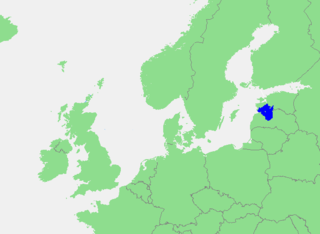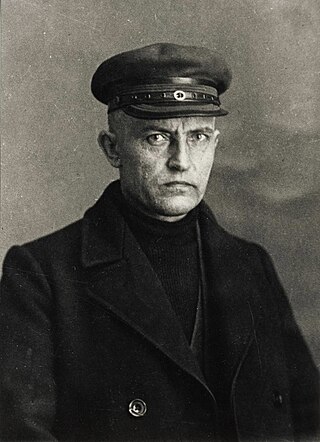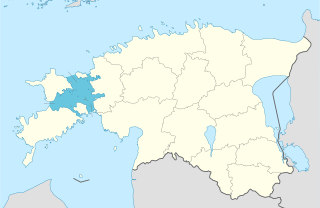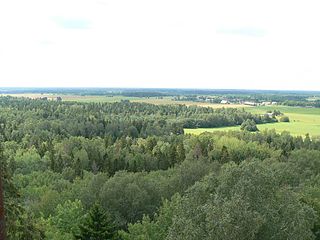Related Research Articles
Estonian is a Finnic language and the official language of Estonia. It is written in the Latin script and is the first language of the majority of the country's population; it is also an official language of the European Union. Estonian is spoken natively by about 1.1 million people: 922,000 people in Estonia and 160,000 elsewhere.

The Gulf of Riga, Bay of Riga, or Gulf of Livonia is a bay of the Baltic Sea between Latvia and Estonia.

Otepää is a town in Valga County, southern Estonia. It is the administrative centre of Otepää Parish. Otepää is a popular skiing resort, popularly known as the "winter capital" of Estonia. During the 2005–2006 season it became the site for FIS Cross-Country World Cup events. Otepää is located the highest of the Estonian cities, up to 152 meters above sea level.

Jaan Anvelt, was an Estonian Bolshevik revolutionary and writer. He served the Russian SFSR, was a leader of the Communist Party of Estonia, the first premier of the Soviet Executive Committee of Estonia, and the chairman of the Council of the Commune of the Working People of Estonia. Imprisoned during Joseph Stalin's Great Purge in 1937, he died from the injuries sustained during a beating by Aleksandr Langfang while in NKVD custody.

West Estonian archipelago is a group of Estonian islands located in the Baltic Sea around Väinameri. The total area is about 4,000 km2 (1,500 sq mi). The archipelago is composed of the islands Saaremaa, Hiiumaa, Muhu, Vormsi and about 900 other smaller islands. The archipelago is separated from the Estonian mainland by the Väinameri Sea.

The history of Estonia from 1918 to 1940 spanned the interwar period from the end of the Estonian War of Independence until the outbreak of World War II. It covers the years of parliamentary democracy, the Great Depression and the period of corporatist authoritarian rule.

Alo Mattiisen was an Estonian musician and composer.
Raimond Valgre was an Estonian composer and musician, whose songs have become some of the most well known in Estonia. During World War II, Valgre was conscripted into the Red Army and was a member of the orchestra for the 8th Estonian Rifle Corps. It is believed that as a result of his service on the Eastern Front Valgre suffered from alcoholism. His music was banned in 1948 by the Soviet authorities. Raimond Valgre died in an accident on 31 December 1949.

Theodor Luts was an Estonian film director and cinematographer, brother of classic writer Oskar Luts. Theodor Luts was the first major figure of Estonian cinematography

Indrek Toome was a Soviet and Estonian communist politician and, after the restoration of Estonia's independence in 1991, an entrepreneur. In 1988–1990 he was the head of the Council of Ministers — informally the "prime minister" — in then Soviet-occupied Estonia.

Omsk State Transport University is a university in Omsk, Russia. It was established in 1961.

The Väinameri or Väinameri Sea is a strait and sub-bay of the Baltic Sea, located between the West Estonian Archipelago and the Estonian mainland, within western Estonia.
The Vares Government was a puppet government named after prime minister Johannes Vares, installed by the Soviet Union in Estonia, in office from 21 June 1940 to 25 August 1940.

Estonia under Swedish rule (1561–1710) signifies the period of time when large parts of the country, and after 1645, entire present-day Estonia, were under Swedish rule. In the wake of the breakup of the State of the Teutonic Order, the Baltic German local nobility in the areas of Harrien (Harjumaa) and Wierland (Virumaa), as well as the city of Reval (Tallinn) in June 1561 asked for and were granted protection by the Swedish king Eric XIV, leading to Swedish involvement in the Livonian War. At the conclusion of hostilities in 1583, Sweden was in control of the northern parts of modern Estonia and Dagö ; the Duchy of Estonia was created from this territory. Following renewed wars between Poland and Sweden, the southern parts of present-day Estonia were incorporated into Sweden by the Treaty of Altmark in 1629. Sweden also conquered the island of Ösel (Saaremaa) from Denmark, and were thus in control of all of present-day Estonia.
Estonian Restoration of Independence, legally defined as the Restoration of the Republic of Estonia, was proclaimed on 20 August 1991. On that day at 23:02 local time, the Supreme Council of the Republic of Estonia, in agreement with the Estonian Committee, declared the illegal Soviet occupation and annexation of the country terminated, and proclaimed the full restoration of the independence of Estonia.

Pandivere Upland is hilly area of higher elevation in Northern Estonia.

Otepää Upland is hilly area of higher elevation in Southern Estonia.

Karula Upland is hilly area of higher elevation in Southern Estonia.
This article lists events that occurred during 1971 in Estonia.

Nigol Andresen was an Estonian and Soviet politician, writer, literary critic, and translator. He was a member of V Riigikogu.
References
- ↑ "Estonica.org - About". Estonica.org. Archived from the original on 23 June 2018. Retrieved 1 January 2019.